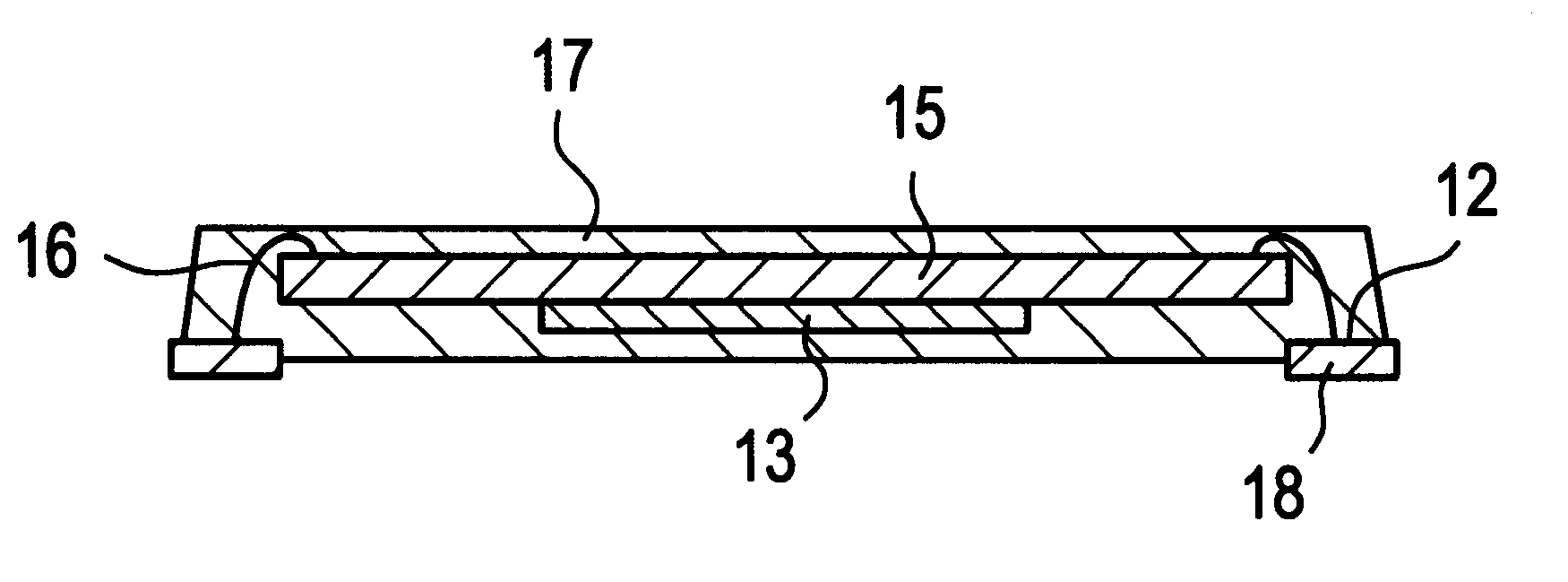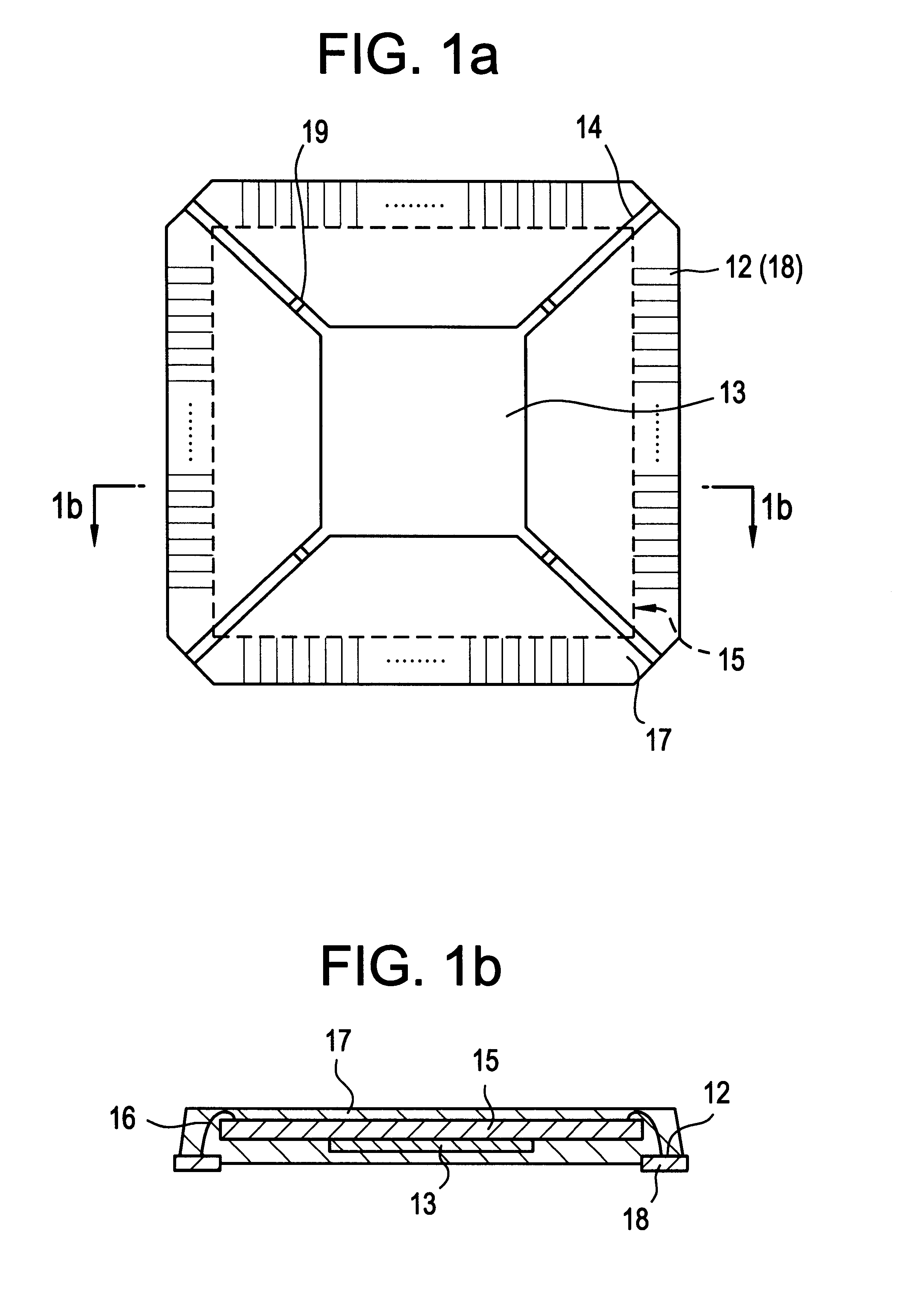Resin molded semiconductor device and method for manufacturing the same
a semiconductor device and resin technology, applied in semiconductor devices, semiconductor/solid-state device details, electrical devices, etc., can solve problems such as serious quality control problems, such as impurity deposition, and inability to efficiently mount,
- Summary
- Abstract
- Description
- Claims
- Application Information
AI Technical Summary
Benefits of technology
Problems solved by technology
Method used
Image
Examples
first embodiment
FIG. 1(a) is a plan view of a resin-molded semiconductor device and FIG. 1(b) is a cross-sectional view thereof taken along the line 1b--1b in FIG. 1(a). In FIG. 1(a), a resin encapsulant 17 is illustrated as being transparent, a semiconductor chip 15 has a contour as indicated by the dashed line, and the illustration of metal fine wires 16 is omitted.
As shown in FIGS. 1(a) and 1(b), the resin-molded semiconductor device of this embodiment includes a leadframe consisting of: inner leads 12; a die pad 13 for supporting the semiconductor chip thereon; and support leads 14 for supporting the die pad 13. The semiconductor chip 15 is bonded on the die pad 13 with an adhesive, and electrode pads (not shown) of the semiconductor chip 15 are electrically connected to the inner leads 12 with metal fine wires 16. And the inner leads 12, die pad 13, support leads 14, semiconductor chip 15 and metal fine wires 16 are encapsulated within the resin encapsulant 17. Also, the die pad 13 is elevate...
embodiment 2
Next, a second embodiment of the present invention will be described. FIG. 9 is a cross-sectional view illustrating a resin-molded semiconductor device of a substrate-bonded type according to this embodiment.
As shown in FIG. 9, the resin-molded semiconductor device of this embodiment is of a substrate-bonded type such as a BGA (ball grid array) type. The device includes: a substrate 24 made of single- or multiple-layered glass epoxy plastic or ceramic; a semiconductor chip 25 mounted on the substrate 24; and metal fine wires 26 for electrically connecting interconnects (not shown) formed on the upper surface of the substrate 24 to electrode pads (not shown) of the semiconductor chip 25. And over the upper surface of the substrate 24, the semiconductor chip 25, interconnects and metal fine wires 26 are molded with an insulating resin encapsulant 27. On the back of the substrate 24, external electrode pads (lands) 28 are formed. The interconnects on the upper surface of the substrate ...
embodiment 3
Next, a third embodiment of the present invention will be described. FIG. 13 is a cross-sectional view illustrating a resin-molded semiconductor device according to this embodiment. The resin-molded semiconductor device of this embodiment includes: a radiator plate; and a semiconductor chip incorporating a device generating a relatively large quantity of heat, e.g., a high-power transistor.
As shown in FIG. 13, the semiconductor device of this embodiment includes: a bed 33, or a support for a leadframe; a semiconductor chip 34 bonded on the bed 33 with a die-bonding member; a metal terminal 35 of the leadframe; a metal fine wire 36 for electrically connecting the metal terminal 35 to the semiconductor chip 34; and a radiator plate 37 for supporting the bed 33 thereon. In this structure, all the members are entirely molded with an insulating resin encapsulant 38, except for the bottom of the radiator plate 37 and part of the metal terminal 35 protruding out of the resin encapsulant 38...
PUM
 Login to View More
Login to View More Abstract
Description
Claims
Application Information
 Login to View More
Login to View More - R&D
- Intellectual Property
- Life Sciences
- Materials
- Tech Scout
- Unparalleled Data Quality
- Higher Quality Content
- 60% Fewer Hallucinations
Browse by: Latest US Patents, China's latest patents, Technical Efficacy Thesaurus, Application Domain, Technology Topic, Popular Technical Reports.
© 2025 PatSnap. All rights reserved.Legal|Privacy policy|Modern Slavery Act Transparency Statement|Sitemap|About US| Contact US: help@patsnap.com



